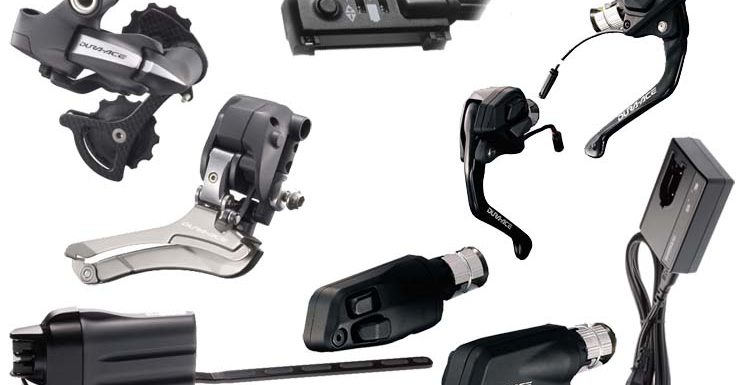
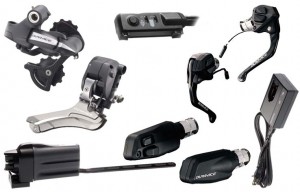 I learned quite a bit about Shimano Di2 when I installed one of the first available Time Trial/Triathlon groupsets on my Cervelo P2. I’ve subsequently answered a lot of questions on forums and article comments, and elsewhere. In doing so, I realized that people have a lot of questions about Di2 and the answers are difficult to find. This lead me to create this article, to consolidate everything I know and have been asked into one location so people can find answers. If you can’t find what you’re looking for below, please leave a comment and I’ll do my best to help.
I learned quite a bit about Shimano Di2 when I installed one of the first available Time Trial/Triathlon groupsets on my Cervelo P2. I’ve subsequently answered a lot of questions on forums and article comments, and elsewhere. In doing so, I realized that people have a lot of questions about Di2 and the answers are difficult to find. This lead me to create this article, to consolidate everything I know and have been asked into one location so people can find answers. If you can’t find what you’re looking for below, please leave a comment and I’ll do my best to help.
Index: There’s lots of info in this post, so here’s an Index to help you find specific sections:
- Di2 General Overview
- Compatibility: Between 6770 10-speed, 6780 11-speed, 9070 11-speed, first-gen 7970
- How to Check Battery Level
- How to Adjust Rear Derailleur Trim
- How to Adjust Front Derailleur Trim
- Dealer Installation Manuals
- Shimano E-tube Project Software – Change Settings and Update Firmware
- Chargers, PC USB Interfaces/Programmers
- Component Overviews
- Shift/Brake Levers
- Dedicated Shift Buttons
- Front Derailleurs
- Rear Derailleurs
- Display Units and ANT Bluetooth Wireless Communication Modules
- Batteries and Battery Mounts (Internal and External)
- Front Cable Connection A Junctions (with charger ports and LED status lights)
- Rear Cable Connect B Junctions
- Cables, Grommets, Cable Install Tools
- List of Components Needed to Build Your Own Di2 System
- Technical Details of the Di2 CANBUS protocol and signaling
System Overview: Shimano Di2 Dura-Ace 9150 and 9070 and Ultegra 6770 and 6870
The second generation Shimano Ultegra 6770/6870 and Dura-Ace 9070 “E-Tube” electronic bicycle shifting systems consist of battery-powered electric derailleurs activated by handlebar mounted push buttons. Power and shift commands are sent via a 2-wire CAN (Controller Area Network) datalink contained within a single cable housing. This design has several advantages over conventional mechanical shifting systems, the most notable of which are:
- Extremely low shifting effort, which generally results in more frequent shifts and therefore better gear ratio selection.
- Greatly improved shift quality, especially for the front derailleur chainrings, allowing shifting under full power with almost no chance of a dropped chain.
- Shifting is available at multiple positions on the handlebars, for example, at the end of the time trial aero bars, on the brake levers, up to in climbing position, and down low the sprint position.
- Automatic trimming of the front derailleur position as the rear derailleur moves back and forth between the smaller and bigger gears. This eliminates unintended contact (and noise) between the front derailleur and the chain.
- Lighter weight vs. equivalent mechanical system. The Shimano Dura-Ace Di2 9070 electronic groupset with internal battery weighs 2047 grams; the Shimano Dura-Ace 9000 mechanical groupset weighs 2074 grams (27 grams more than Di2.)
- Multi-Shift: Pressing and holding a rear derailleur shift button results in shifts through multiple gears. The rate of shifts can be configured using the PC computer interface cable and the free Shimano E-tube Project software.
- Synchronized Shifting: Starting with Dura-Ace 9150, automated Synchronized Sifting of the front derailleur is an option. Two SHIMANO Synchronized Shift modes will be available:
- Full SHIMANO Synchronized Shift: the front derailleur reacts based on the rear derailleur’s shift action. This essentially means that, when activated, there is no need for two separate shifters to control front and rear derailleurs, the two buttons on one shifter will control both derailleurs.
- Semi SHIMANO Synchronized Shift mode: the rear derailleur reacts based on the front derailleur’s shift action, shifting to the next most appropriate rear gear when the rider makes a front shift.
- R9120, R9170 – syncroshift enabled with firmware 3.2.0 or newer
- 6870, 9070 – syncroshift enabled with firmware 3.2.1 or newer
- 6770 – no syncroshift firmware update will be offered
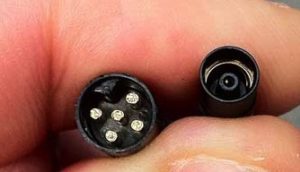 Historic Info on the older first generation 5-wire Shimano Dura-Ace Di2 DA-7970 system and how it compares to the new E-tube 2-wire system:
Historic Info on the older first generation 5-wire Shimano Dura-Ace Di2 DA-7970 system and how it compares to the new E-tube 2-wire system:
Released in 2009, the 7970 operated using a very basic 5-wire electronic system. Each shift button was connected to a different wire; shorting the specific wires together controlled the derailleur upshifts and downshifts. Because the first generation 7970 used completely different technologies than the newer 2-wire systems, none of the components are cross-compatible. At this point, Shimano is not expected to offer any updates or new components using the first generation 7970 architecture; everything from now on will be based on the newer 2-wire E-tube design. The second generation design offers several advantages, which include: 1) smaller wire size, smaller connector size, waterproof connectors; 2) all switches can be reconfigured in software to send upshift or downshift commands to either the front or rear derailleur; 3) firmware updates can add new features (such as multi-shift) and compatibility with new components.
Compatibility: Dura-Ace 9070 and Ultegra 6770 / 6870 (and old 5-conducter 7970)
The confusing naming system used by Shimano makes it difficult to figure out what each component is, much less what is compatible between systems. Here are some compatibility guidelines:
- Nothing from the first generation (4-conductor / 5-conductor) Dura-Ace Di2 7970 system is compatible with any other newer system. It was replaced by the (2-conductor) E-tube systems. No parts are inter-operable between 7970 and any other Di2 System.
- In general, every electronic Di2 component is compatible between the Ultegra 6770, 6870, and Dura-Ace 9070 systems (see exceptions below.) This means that all of the road bike Ultegra/Dura-Ace dual control brake levers/shifts, time trial shifters, and climbing shifters can be used with either Ultegra 6770/6870 or Dura-Ace 9070 front and rear derailleurs. Any of the Ultegra/Dura-Ace controllers (A Junctions) can be used with either system. All components use the same cables and connectors.
- Firmware Update Required to Make Older Components Compatible with Newer Components: If you add a new component and it doesn’t work, update the firmware using the PC USB adapter and the Shimano E-tube Project Software for Windows.
- Synchronized Shifting and Bluetooth Wireless Units can be added to all E-tube Ultegra and Dura-Ace systems but the battery has to be upgraded to the BT-DN110 Internal Battery or BM-DN100 External Battery Mount. To add Bluetooth capability, a EW-WU101 or EW-WU111 inline transmitter must be added to road bikes and for mountain bikes, the SC-MT800 or SC-M9051 display/transmitter unit must be added.
- Compatibility Exceptions:
- Note 1 – Sprint Shifter Exception: The Sprint Shifter is the only exception for shifter incompatibility. It has a different wiring connector (and internal components) that can only plug into a unique/dedicated third port on the Dura-Ace ST-9070 Dual Control Brake Levers/Shifters and also the ST-6870 Levers. There is no sprint shifter port on the ST-R785 Hydraulic Levers.
- Note 2 – Can’t mix 10-speed/11-speed front/rear Derailleurs: It is no longer possible to use a 10-speed front derailleur with an 11-speed rear derailleur (and 11-speed front with 10-speed rear.) See note farther below to read the history on this if you want all the messy details.
- Note 3 – Front A junction and Internal Battery: Since the February 2015 firmware update, the older SM-EW67-A-E Front Junction A is no longer compatible with the BTR2 Internal Battery because it does not have the charging port to charge the internal battery. The SM-EW90 Front Junction (with integrated charging port) should be used instead. The SM-EW67 still works with the external battery.
- Note 4 – Update the Firmware to make components compatible: If the firmware on all components is not updated to the latest version, some components may be not operate correctly with one another. So download the latest E-tube software and update everything and it should work.
- Note 5 – All Shifters work with all 10-speed and/or 11-speed Rear Derailleurs: All of the shifters are compatible with either the 10-speed Ultegra 6770 or 11-speed Ultegra 6870/Dura-Ace 9070 systems as long as they all have the latest firmware. The rear derailleur is the only component that “knows” or “cares” how many rear gears are available. The shifters only send upshift/downshift commands and do not “know” or “care” which gear is currently selected and how many total gears there are.
- Note 6 – SM-BTR1 External Battery and SM-BMR1 Mount firmware updates: The more expensive dedicate service tool (SM-PCE1 PC Interface) must be used to upgrade the firmware on the external battery/mount.The external battery and battery mount can not receive firmware upgrades via the SM-EW90 Front Junction A and the SM-BCR2 PC Interface/Battery Charger. (The SM-EW90 will work in a system with an external battery, but a firmware update can cause them to become incompatible until both are updated independently using the appropriate PC Interface and the Shimano E-Tube Project software.)
- See the Shimano E-tube compatibility chart version 3.4.3 for more details
Compatibility: 11-Speed Rear Derailleur and 10-speed sprockets/wheels
The 11-speed Dura-Ace 9070 and Ultegra 6870 rear derailleurs are designed exclusively for 11-speed rear sprockets and 11-speed Front Derailleurs. Shimano does not provide a way to recalibrate/reprogram them for a 10-speed setup. The sprocket spacing is slightly smaller and the overall range of travel slightly longer on 11-speed systems. If you have 10-speed wheels and 10-speed sprockets, you should use the 10-speed RD-6770 rear derailleur and a 10-speed FD-6770 front derailleur.
Similarly, a 10-speed RD-6770 rear derailleur should not be used with 11-speed sprockets. There will be chatter in some gears, and there might be slow-shifts or self-shifts.
It doesn’t matter which shifters are used; the shifters send upshift/downshift commands regardless of which derailleur config is being used. Shifters do not “know” or “care” which gear is currently selected and how many total gears there are.
Front Chain Rings: In general, most any front chain rings will work, rigid forged rings work best with Di2 due to high front derailleur shift forces. Shimano chain rings tend to be the best, but most others work as well. A 10-speed specific or 11-speed specific chain should be used, but the differences between them are minimal and can generally be mixed/matched without issue.
How to convert “non-upgradeable 10-speed only” wheels such as Zipp 900/Sub9 Disc Wheels to 11-speed: “the spacing between a Campy 11 and Shimano 11 is close enough that you can use the cassettes interchangeably. If you get a Campy free hub body, the 2 shims (part# is on the Zipp website, just search for Campagnolo 11) and a Campy cassette and you’re ready to ride with all 11 cogs available to use.” via slowtwitch.com
But it’s an emergency and I need to use a 10-speed wheel. . . In emergency situations, 11-speed rear derailleurs can be used with 10-speed sprockets. There will probably be chatter in some gears, and there might be slow-shifts or self-shifts. To setup an 11-speed rear derailleur for a 10-speed sprocket setup, adjust the mechanical limit screw so that it can’t shift into the missing 11th sprocket position, then follow the rear derailleur adjustment procedures listed below.
Included for very motivated individuals only: 10-speed front derailleurs can be used with 11-speed rear derailleurs if the shifters and battery have firmware installed from E-tube software version 2.5.2 or earlier. Shimano disabled support for this 11-speed and 10-speed cross-matching with later firmware updates. For informational purposes only, the details of how to regain compatibility are detailed below.
- Important Notice 2014-07-14: There is a compatibility issue with Shimano e-Tube software/firmware versions v2.6.0 and later that prevents 10-speed front derailleurs (FD-6770) from working with 11-speed rear derailleurs (RD-6870) and 11-speed front derailleurs (FD-6870) from working with 10-speed rear derailleurs (RD-6770). DO NOT UPDATE FIRMWARE using Shimano e-Tube software v2.6.0 or later if you are mixing an FD-6770 front derailleur and a RD-6870 11-speed rear derailleur, or a FD-6870 with a RD-6770.
- The problem component is the battery (external battery mounts SM-BMR1 and SM-BMR2, internal seat post battery SM-BTR2.) If you keep battery firmware at v2.0.6 or earlier, the system will continue to function properly. Shimano e-Tube Software v2.6.0 will update battery firmware to v3.0.5, and will not allow the RD-6870 to work with a FD-6770 setup.
- If the battery firmware is updated to 3.0.5, it CAN NOT be rewritten back to the older version. You will need to need to replace a derailleur so that both are 6770 10-speed or so that that both are 6870 11-speed. (The other option is to get get a battery with the older firmware and never update it.)
- Here’s a link to the “last known good version” of the Shimano e-Tube software to work with a mixed 10-speed/11-speed system: E-tube_Proj_V_2_5_2.zip Use this version and do not connect to the internet when using it so that E-tube can’t check for updates when open.
- To roll-back newer versions of battery and shifter firmware, install E-tube version 2.5.2 and made a copy of “C:\ProgramData\E-tube Project\FW” which has all the firmwares packaged in that version of E-tube. Next, install the latest version of E-tube. Then copy all the firmwares from the the 2.2.3 version back to the same location “C:\ProgramData\E-tube Project\FW” for the latest version (note: ProgramData is a hidden directory, click here for details on how to view it.). Next, the trick is to find the firmware you want to downgrade (pretty easy from the name and version in the file name), and then rename it to the same name as the latest version, but increment the last version digit by one. Then connect to the bike with E-tube (without an internet connection) and it will identify that a firmware upgrade is available for that component and allow you to do the firmware “upgrade” to the older version of firmware. Now exit E-tube and then rename the firmware file back to original to prevent the issue in future. E-tube will then try to upgrade again but just don’t let it do that. This should get a bike that did nothing (not even enter adjustment mode) to a fully working state by reverting the battery and shifters. Running latest firmware in derailleurs seems to be fine. (thanks to commenter vosadrain)
- It will not be possible to charge the BTR2 internal battery using the BCR2 USB charger unless you also downgrade the firmware of the BCR2 USB charger as well.
- Note however that latest E-tube software will say the setup is unsupported and will not allow programming. To do programming, disconnect the internal battery and connect a spare external battery. This allows making settings changes. To program the BTR2 itself, I just connect to the BTR2 by itself (no other components) and the E-tube software will allow firmware changes to it. Or try using the 2.5.2 version of E-tube.
- Alternatively, buy a Di2DIY internal seat post battery kit and you will not have to go through the firmware downgrading. The kit makes it possible to run all components with the latest E-tube firmware. Also worth noting some firmware updates were done to fix power distribution errors in the FPGA’s that would allow the batteries to drain down when the bike was just sitting.
Checking Battery Charge Level:
A single battery charge should give at least 1500 miles of riding. Most riders will not need to charge the battery more than twice a year.
To check the battery charge remaining, press and hold any shifting switch for 0.5 seconds or more. The amount of battery charge remaining will be indicated by the light on Front Controller A Junction.
- 100% remaining: Illuminates green (for 2 seconds)
- 50% remaining: Flashes green (5 times)
- 25% remaining: Illuminates red (for 2 seconds)
- 0% remaining: Flashes red (5 times)
When the battery charge is low, first the front derailleur will stop operating, and then the rear derailleur will stop operating. When the battery charge has been fully spent, the derailleurs will be fixed at the last gear shifting position. If the battery indicator is illuminated red, it is recommended that you recharge the battery as soon as possible.
Adjusting the Rear Derailleur Trim:
If you switch between multiple rear wheels, it’s very likely that the sprockets on different wheels won’t be in exactly the same relative position to the rear derailleur, resulting in that annoying clicking sound as the chain makes contact with an adjacent sprocket. Follow the steps below to properly align the rear derailleur with the rear sprockets.
- Shift the rear derailleur to the 5th sprocket position. Press the button at the junction (A) of the SM-EW67-A-E until the red LED illuminates in order to switch to rear derailleur adjustment mode. Note that if you keep pressing the button after the red LED has illuminated, protection recovery operation will begin.
- If shifting switch is pressed once while the initial setting condition is active, the guide pulley will move one step toward the inside. If shifting switch (Y) is pressed once, the guide pulley will move one step toward the outside.
- Note: The guide pulley can move 15 steps inward and 15 steps outward from the initial position, for a total of 31 positions.
- Note: When adjusting, the guide pulley will overrun slightly and then move back in an exaggerated movement so that you can check the adjustment direction. When checking the positions of the guide pulley and the sprocket, check at the position where the guide pulley finally stops.
- While turning the front chainwheel, operate shifting switch to move the guide pulley toward the inside until the chain touches the 4th sprocket and makes a slight noise.
- Next, operate shifting switch 4 times to move the guide pulley toward the outside by 4 steps to the target position.
- Press the button at junction (A) until the red LED turns off in order to switch from rear derailleur adjustment mode to gear shifting mode. Shift to each gear and check that no noise is generated at any gear position. If fine adjustment is needed, switch back to adjustment mode and readjust the rear derailleur.
- Note: if you have customized your shifters and swapped buttons, this will change which shifter and buttons control the micro-adjustments. Also, if you hit the wrong buttons while trying to set the FD trim, you can actually alter the setup of your RD. Be certain that you’re hitting the correct adjustment buttons.
- If you have a Garmin or similar head unit and a SM-EWW01 ANT module, the display will automatically switch into derailleur trim display when you activate that mode (i.e. by pressing the button at the junction (A) of the SM-EW67-A-E.) It will give you the trim position in either + or – 12 positions. When switching wheels, simply take note which position suits which wheel/sprocket/trainer, and trim to that level each time you change. This removes the guesswork and makes changing from wheel to trainer simple.
Note on FD-6870 Front Derailleur Trim:
The FD-6870 trim adjustment effects the auto-trim positions. The adjustment feature is accessible via either the A-Junction box, or the “Front derailleur adjustment setting” in the e-tube software, and should be used only after you have already set the physical inner/outer limit screws. So for example, if the FD outer plate rubs the chain when using the 6th largest cog, you would want to adjust the FD trim outward a couple ticks. However, you can only perform this adjustment while in the big-ring/big-cog combination. Etube forces the derailleurs into this maximum cross-chained position, whereas during the manual method you must shift to these positions yourself. (Thanks to commenter Bryan B for the info.)
Dealer Manuals:
The dealer’s manuals contain the most detailed information available from Shimano. If you’re looking for detailed installation instructions, check here:
- Shimano Ultegra 6770 Dealer’s Manual: http://techdocs.shimano.com/media/techdocs/content/cycle/SI/Ultegra/UltegraDi2/6770Di2_DM_EN_v1_m56577569830773882.pdf
- Shimano Ultegra 6870 Dealer’s Manual: http://si.shimano.com/php/download.php?file=pdf/dm/DM-UL0001-00-ENG.pdf
- Shimano Dura-Ace 9070 Dealer’s Manual: http://si.shimano.com/pdf/dm/DM-DA0001-00-ENG.pdf
- Shimano Alfine Di2: http://si.shimano.com/php/download.php?file=pdf/dm/DM-AL0001-03-ENG.pdf
Shimano E-tube Project Configuration and Firmware Update Software for Windows:
Shimano E-tube Project Wireless for iOS and Android: Announced on April 15, 2016 but as of yet unreleased, these apps will allow configuration of shift profiles (multi-shift on/off, multi-shift delay between shifts, shifter button assignments) and firmware updates over Bluetooth. To function, a Shimano Di2 Bluetooth Adapter, such as the MT800 digital display, is required.
Shimano E-tube Project Windows PC Software: This free software is used to update the firmware of all components. It works with the SM-BCR2 Charger + USB Adapter and the SM-PCE1 Diagnostic Adapter. The software is used to change the configuration of each shift button / lever (any can be programmed to upshift or downshift either the front or the rear derailleur.) It can also be used to enable multi-shift (multi-shift is where the shifter is held and the rear derailleur shifts through multiple gears until the shifter is released.) The delay between of the gear changes during multi-shifting can also be adjusted. The software is available from http://e-tubeproject.shimano.com/
Older versions of the e-tube software are available from these links: 2.5.2
PC & Mobile Interfaces, Chargers, and Software:
SM-BCR1 Battery Charger: This is used to charge the external battery. The part number for the battery charger wall cord is SM-BCC1.
SM-BCR2 Charging and PC Connection: for SM-EW90-A 3-port and SM-EW90-B 5-port A Junctions. This plugs into a special port on the side of the A junctions (which is covered by a rubber flap.) This adapter charges the internal battery when first plugged into the A junction; it must be powered by a standard USB Wall charger (such as that used for an Apple iPhone) or a PC that is powered-on. If the Shimano E-Tube Project Software is launched on the Windows PC with the SM-BCR2 attached, the SM-BCR2 will switch from charging mode to configuration mode. It must be detached from the computer and reattached to switch back to charging mode.
- It takes about 2 hours to charge the internal battery.
- Amber light=charging.
- Light turns off when done.
- If the Amber light does not come on when plugged in, this indicates battery is not discharged enough to charge.
- Light flashing indicates something is wrong, like trying to charge a external battery through a BMR.
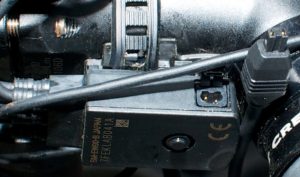
Hacking the SM-BCR2 to have a standard Di2 cable connector: If your 3-port or 5-port junction is inaccessible for charging, there is an alternative hack method to connect it to the system through a standard Di2 port. With basic soldering skills you can hack the BCR2 to be used with any setup. Buy any length EW-SD50 wire, cut off one end. Cut the wire on the output side of the BCR2. Splice the two wires together, so that the output wire of the BCR2 is now a standard Di2 connector. The charger has an inner (white) and outer (shield) wire; connect the inner white wire to the SD50 red wire; connect the charger outer shield wire to the SD50 black wire. You will then be able to plug the BCR2 into any Di2 port. Or use a SM-JC40 junction B and another length of EW-SD50 wire and go through the RD (by using the SM-JC40 to connect the rear derailleur, new output wire of the EW-SD50, and the wire that ordinarily connect the rest of the system to the rear derailleur.) Thanks to @Di2diy for the info.
SM-PCE1: This PC Configuration and Diagnostics adapter will not charge the internal battery. It offers the same configuration options as the SM-BCR2, but also add some advanced diagnostic and troubleshooting features that the SM-BCR2 does not have. It attaches to via the standard E-tube wire (just like the EW-SD50 cables) rather than to a dedicated port on the side of the front A junction.
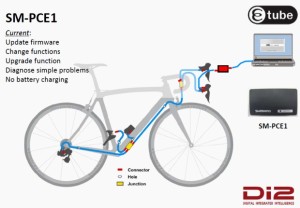
Bluetooth and E-tube Apps for Apple iOS and Android: Bluetooth wireless modules are available to allow system settings to be adjusted via the mobile applications that connect via Bluetooth Adapters.
Component Overview:
The confusing naming system used by Shimano makes it difficult to figure out what each component is, much less what it does and how it fits into an a complete Di2 system. Here’s an overview of all the major Ultegra and Dura-Ace Di2 components.
Dual Control Brake Levers/Shifters (a.k.a. Brifters):
ST-6770 Ultegra Road Dual Control Brake Levers/Shifters: The Ultegra version can be used with the climbing shifters. They are sold in in left/right pairs and are also available separately.
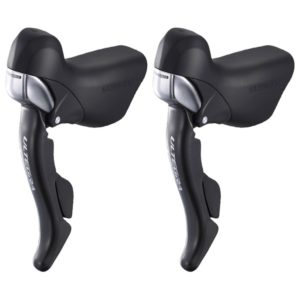
ST-9070 Dura-Ace Road Dual Control Brake Levers/Shifters: The main advantages these have over the ST-6770 version is slightly lighter weight and compatibility with the low-mount sprint shifters. As like the Ultegra version, they are compatible with the climbing shifters. They also have hidden button under the rubber hoods that can activate screen changes on cycling computers from Garmin, Magellan, Pioneer, and Shimano (Shimano SM-EWW01 ANT Wireless Broadcast Module required.)
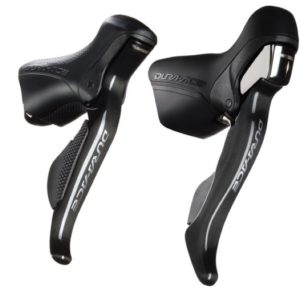
ST-9071 Dura-Ace Time Trial/Triathlon Dual Control Brake Levers/Shifters: These levers provide shifting from the pursuit bar position on time trial bikes. There is no Ultegra option offered at this time. These are available as left/right pairs, or can be ordered separately. These do have a permanently attached wire with a male end for connection the the SM-EW90 front “A” junction. Combined weight both levers: 117 grams.
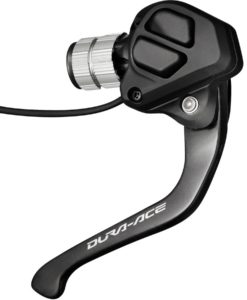
ST-R9160 (standard cable brakes) and ST-R9180 (hydraulic brakes) Time Trial Dual Control Brake Levels/Shifters: These are the lower-profile shifters offered with the newer Dura-Ace R9150 groupset.
ST-6871 Ultegra Time Trial/Triathlon Dual Control Brake Levers/Shifters: Ultegra version of the ST-9071 Dura-Ace shifters. Slightly heavier and much less expensive than the Dura-Ace version. Combined weight both levers: 142 grams.
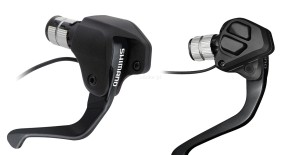
ST-R785 Hydraulic Road Dual Control Brake Levers/Shifters: These hydraulic road shifters are compatible with both the climbing and sprint shifters. These are compatible with the SM-RT99 centerlock 140mm and 160mm rotors and WH-RX31 wheelset (which as no standard rim brake track.) These require the BR-785 dual piston hydraulic disc calipers. They do not have the special wiring port required for the SW-R610 Sprint Shifters and a SM-EW90-B 5-port junction A is required to use the SW-R600 climbing shifter.
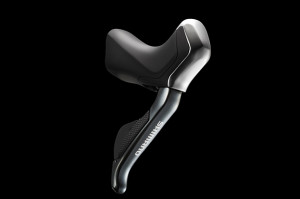
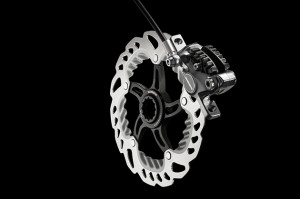
ST-6870 Ultegra Road Dual Control Brake Levers/Shifters: These road shifters are compatible with both the climbing and sprint shifters.
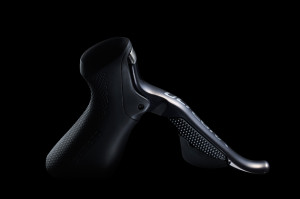
Dedicated Shifters:
SW-R671 Dura-Ace 2-Button Time Trial/Triathlon Bar End Shifters: These shifters are installed on the end of time trial aero bars. By default, the left shifter upshifts/downshifts the front derailleur; the right controls the rear derailleur. For both, the lower button upshifts into a harder gear and the upper button downshifts to an easier gear. This can be changed using the Shimano E-tube Project software; the functions of the left and right sifters can be switched with one another as well. These are available in pairs or separately.
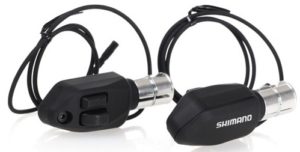
SW-9071 Dura-Ace 1-Button Time Trial/Triathlon Bar End Shifters: These shifters have only one button each and are intended to control only the rear derailleur, with one sending the upshift command and the other the downshift command. (I personally think this version is absolutely worthless. Why have 2 SW-9071 shifters at twice the price and twice the weight, when you can just buy a single SW-R671 Right shifter instead.)
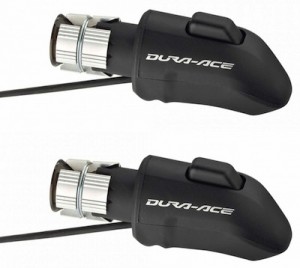
SW-R600 Climbing/PAVE Shifter: This shifter is for road bikes and is mounted on the upper horizontal portion of the handlebar, or any other location comfortable for the rider. They can be used in addition to the Dual Control Brake Lever/Shifter, or can be used on their own by plugging directly into a SM-EW90-A 3-Port Junction or SM-EW90-B Dura-Ace 5-Port Junction.
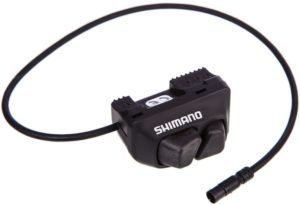
SW-R610 Dura-Ace Sprint Shifter: This is the only component using a unique wiring connector; it is only compatible with the ST-9070 Dura-Ace and Ultegra ST-6870 Road Dual Control Brake Levers/Shifters. Unlike all of the other shifters, the sprint shifters do not contain a circuit board; they do not show up as components on the CAN bus network. Instead, the sprint shifters are simple momentary switches that activate the circuit board on the host Dual Control Brake Lever/Shifter. The host dual control lever is what sends the shift command. (Note: Any momentary switch can be attached to the sprint shifter port on the Dual Control Levers by splicing into a standard EW-SD50 wire to act as remote shifters.)
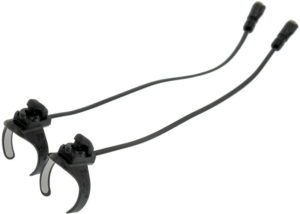
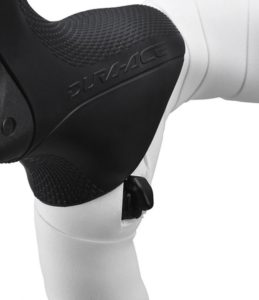
Alfine SW-S705 Right Flat-Bar Shifter: Reported to work with other non-Alfine setups.
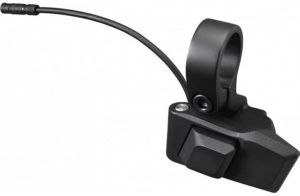
SW-R9160 Time Trial bar-end shifters (pair): These are-end shifters directly control the rear derailleur, with one for the upshfit and one for the downshift. The front derailleur is controlled automatically via automatic Synchronized Shifting. These shifters require the BT-DN110 Internal Battery for synchronized shifting.
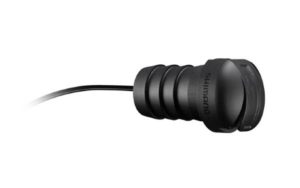
SW-R9150 Climbing shifters (pair): These tiny climbing shifters are about as small as the sprint shifters, but can be directly connected to a junction box and do not have to be connected as slave buttons to a brake/shift lever special port. They come with plastic mounts to make it easier to attach to bars beneath bar tape. They are ideal for synchronized shifting, with one controlling the upshifts and the other downshifts. These shifters require the BT-DN110 Internal Battery for synchronized shifting.
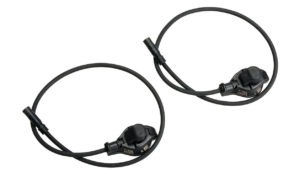

Front Derailleurs:
FD-6770: Ultegra Front Derailleur
FD-6870: Ultegra Front Derailleur, pretty much identical to the FD-6770 but with a slightly larger diameter adjusting screw (to better dissipate the shifting forces).
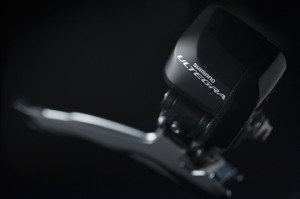
FD-9070: Dura-Ace Front Derailleur
FD-R9150: Dura-Ace Front Derailleur for 9150 systems; features slightly reduced weight vs. 9070.
Rear Derailleurs:
RD-6770: Ultegra 10-Speed Rear Derailleur, compatible with gears up to 28 teeth.
RD-6870: Ultegra 11-Speed Rear Derailleur, compatible with gears up to 32 teeth (for the GS version).
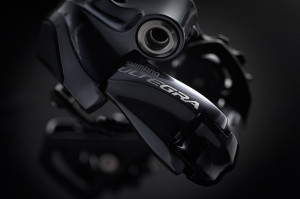
RD-9070: Dura-Ace 11-Speed Rear Derailleur, lighter weight version on which the RD-6870 is based.
RD-R9150: Dura-Ace 11-Speed Rear Derailleur with 30-tooth sprocket compatibility and modified “Shadow RD” geometry to keep the mechanism close to the rear wheel to help avoid damage in the event of an accident.
Alfine SG-S505 and SG-S705: The Shimano series targets comfort and urban bikes. It uses an 8-speed (505) or 11-speed (705) internal epicyclic rear hub. It is believed to be compatible with other Di2 ETube components but this has not been verified.
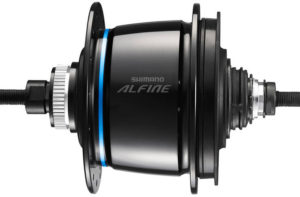
Display / Wireless Communication:
SM-EWW01 ANT Wireless Broadcast Module: This module wirelessly broadcasts Di2 data (front and rear gear selection details, gear ratio, battery life) to a cycling computer using the ANT protocol. It is compatible with Dura-Ace 9070, Ultegra 6870 Di2 and Ultegra 6770 E-tube road shifting systems. SM-EWW01 plugs into the E-tube wiring system between existing components. It has an 2 wiring ports, so it can be connected between a front shifter and the Front Junction A, or at the rear derailleur (between rear derailleur and Etube wire.) It transmits through a proprietary private ANT wireless protocol, which may eventually become a standard public ANT+ protocol. It is powered by the same Di2 system battery. It is currently compatible with the Garmin Edge 1000, Mio 505, and the PRO SCIO cycling computers (with more to come.) The hidden buttons under the hoods of the 9070 shifter levers will switch screens on the cycling computer when paired with this module. It does not currently allow for shifting control from a cycling computer/device and it is not clear that this functionality will ever be offered. The SM-EWW01 is 38mm long, 25mm wide, 12.5mm high, and weighs less than 5 grams. It does not come with any wires; 1 wire would have to be added if adding this module to an existing Di2 system.
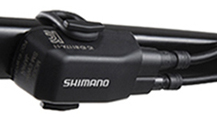
EW-WU101 and EW-WU111 ANT and Bluetooth Wireless Broadcast Modules: These modules are similar to the SM-WEE01 but also include Bluetooth capabilities in addition to ANT capabilities. They require the BT-DN110 battery or the BM-DN100 Battery Mount and cannot be used with the SM-EW67 Front A Junction.
SC705 Alfine Display Unit: This unit displays the battery level and the rear derailleur gear selection. It is powered by the system battery and has a port for the SM-BCR2 internal battery charger / USB diagnostic tool. It is primarily designed for Alfine systems (both 8 505-series and 11 speed 705-series). It is compatible with Ultegra and Dura-Ace Di2.
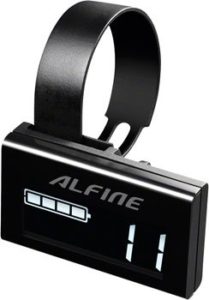
MT800 Digital Display with Bluetooth: Primarily aimed at XT mountain bike applications, this display allows toggling between the 3 synchronized shift modes (where both derailleurs are intelligently coordinated in unison by one pair of buttons, so no need for discrete shifting of the front derailleur.) It also shows battery level, gear position, shift mode and FOX iRD suspension position. The Digital Display required the new BT-DN110 battery. Existing Di2 XT systems are upgradable to be compatible with the new digital display after battery upgrade and firmware upgrade. This display has 3-port Di2 Cable junction and charging port integrated into the back and serves as a Front A Junction.
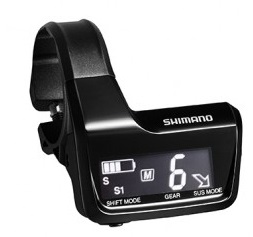
Batteries and Battery Mounts:
The batteries contain the main controllers for the system. It is therefore required to upgrade the battery to get features released in new versions of Di2 (such as Synchronized Shifting that automatically controls the front derailleur based on rear derailleur shifting.)
SM-BTR1 External Battery: This external battery must be used with the SM-BMR1 battery mount. It is removed from the mount and charged using a dedicated charger.
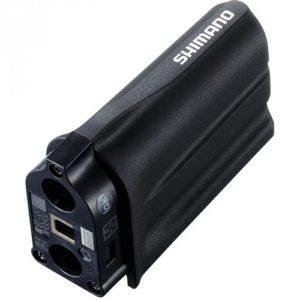
SM-BMR1 and SM-BMR2 External Battery Mount: This mount attached to bottle cage mount points or other dedicated frame mounts. It is available in 3 different mount lengths: -I (intermediate length), -S (short length), -L (long length). The SM-BMR2 is an updated version of the SM-BMR1.
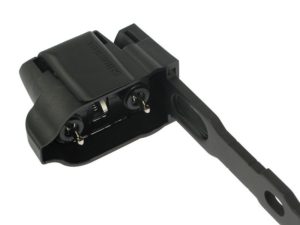
SM-BTR2 Internal Battery: This battery is typically mounted in the seat post or seat tube of the frame. It is charged by plugging the SM-BCR2 Charging Cable/PC Adapter into the SM-EW90-A or SM-EW90-B Front A junctions.
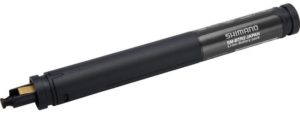
BT-DN110 Internal Battery: This battery is required for Bluetooth wireless units and road groupset Synchronized Shifting functionality.
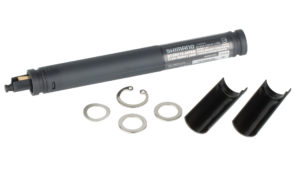
BM-DN100 External Battery Mount: This battery is required for Bluetooth wireless units and road groupset Synchronized Shifting functionality.
Front A Junctions:
SM-EW67-A-E Ultegra 3-Cable Junction: This is the original front junction with 2 integrated cables to connect to the dual control brake lever/shifters. The male cable ends on this Front A Junction will not mate directly to the male cable ends on any of the Time Trial/Triathlon dual control brake shift levers or shifters; SM-JC41 Rear B Junctions can be used to connect this front A junction to TT/Triathlon shifters. This Junction works only with External Batteries, not Internal Batteries.
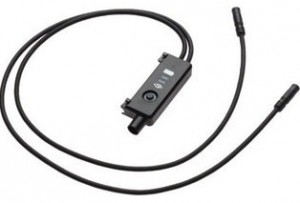
SM-EW90-A Dura-Ace 3-Port Junction: This front “A” junction is most commonly used in road bike setups. 2 ports connect to the dual control brake / shift levers; the third port is for the cable that leads to the bottom bracket junction.
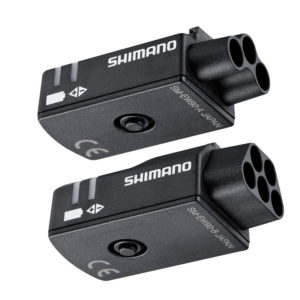

SM-EW90-B Dura-Ace 5-Port Junction: This front “A” junction is primarily used in the Time Trial / Triathlon setups. 2 of the port are for the brake/shifter dual control levers, 2 of the ports are for the aer0 bar bar-end shifters, and the 5th port is for the cable that runs to the bottom bracket (where the B junction joins the wires from the front A junction, front derailleur, rear derailleur, and battery.)
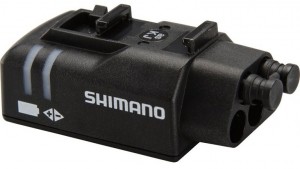
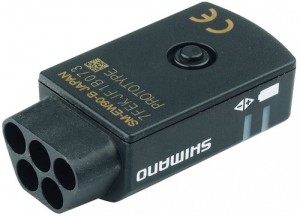
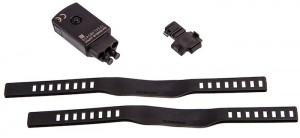
EW-RS910 Internal Bar-end Junction: This junction is installed into the end of a bar or in a dedicated frame port. It facilitates internal cable routing.
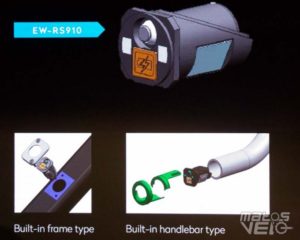
B Junctions:
SM-JC41 Internal Junction: This version has the exact functionality as the SM-JC40 external version, but doesn’t have the mounting tab for being bolted to the bottom bracket or wrapping the extra cable lengths. It has 2 ports on one end and 2 on the other, making it more compact. In addition to being located at the bottom bracket to connect the A junction, battery, front derailleur, and rear derailleur, it can be used at the handle bars to join multiple shifters prior to being connected to the A Junction.
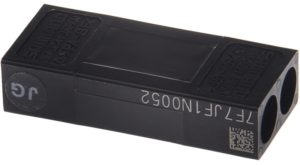
SM-JC40 External Junction: This version is intended to be attached to the frame using the bolt that is commonly located underneath the bottom bracket housing. This junction contains no electronics; it’s sole purpose is to join 4 connectors together, which are usually the wire from the front A junction, the battery, the front derailleur, and the rear derailleur. There are wire holders above the housing to capture the extra wire length by wrapping it back-and-forth.
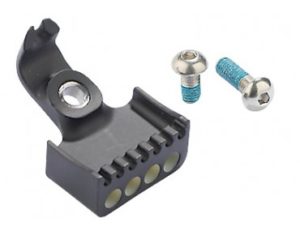
Cables, Grommets, and Cable Remove/Install Tool:
EW-SD50 Cables: These cables connect the front A junction, the battery, the front derailleur, and the rear derailleur to the rear B junction, which is typically located near the bottom bracket (near the cranks.) These are available in lengths of 300mm, 350mm, 400mm, 500mm, 550mm, 600mm, 700mm, 750mm, 950mm, 1000mm, 1200mm, 1400mm.
SM-GM01 Grommet: These round grommets are used when drilling round holes for internal cable routing, or with existing round holes. The required hole diameter is 6mm (6mm = .236 inches. Use a 7/32-inch drill bit and then “wallow-out” the hole to make it a little bigger; a 1/4-inch drill bit will work but is just slightly larger than necessary.)
SM-GM02 Grommet: These 7mm x 8mm oval shape grommets are used in some situations / frame designs.
Shimano TL-EW02 Ultegra DI2 E-Tube Tool: This tool is used to connect and disconnect the Etube wires. They are extremely difficult to connect/disconnect by hand, and pliers or other tools can damage the wires. Don’t get this confused with the TL-EW01 tool, which is for the older 5-wire 7970 cables. (My Dura-Ace TT Dual Control Levers came with one of these tools, but no other components did.)
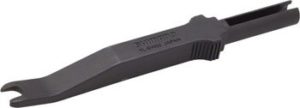
Common Questions (via Shimano):
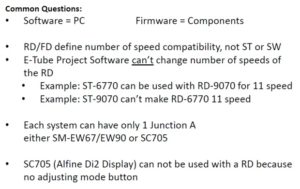
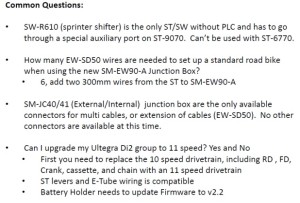
Note: it is not necessary to replace the FD from upgrading from 10-speed to 11-speed.
What Components do I need to put together my own Di2 system?
Because of the huge number and variety of components, it’s very difficult to figure out what is actually necessary and what is optional. So here is a list, for the setup I recommend: Ultegra 6870. It starts from the handlebars and works backwards. (This assumes both front and rear derailleurs, but you actually don’t have to have both; you can pick one or the other and only the corresponding front shifter to go along with it.)
- Any Type of Shifters / Shift Buttons. The Dual Control Brake Levers/Shifters are not required. You can get the just the climbing shifters or Triathlon/TT bar-end shifters, and then potentially add the Dual Control Levers/Shifters at a later point. (The only exception is the Sprint shifters, which require specific Dual Control Levers/Shifters with special ports as noted elsewhere in this article.) Amazon.com link
- EW-SD50 Wires 1 and 2 between the front shifters and the Front Junction A (0nly for some shifters). This is a bit confusing, because some of the front shifters come with wiring attached to them and some of them require purchasing separate wires. In general, most of the stand-alone shifters come with wiring, as do the TT/Triathlon dual control shifters/levers, but the road dual control levers do not. Amazon.com link
- Front Junction A. I recommend the SM-EW90-B 5-port front junction A as it provides the most upgrade flexibility; get the 3-port option only if you’re positive you’re never going to add more shifting components. The older SM-EW67-A-E has 2 wires built-in to connect with each of the dual control shift/brake levers; it doesn’t offer much flexibility or compatibility with a TT/Triathlon setup or adding additional shifters. Amazon.com link
- EW-SD50 Wire 3 between the Front Junction A and the 4-port Rear Junction B connector. Amazon.com link
- EW-SD50 Wire 4 between the Rear Junction B and the Front Derailleur. Amazon.com link
- EW-SD50 Wire 5 between the Rear Junction B and the Battery. Amazon.com link
- EW-SD50 Wire 6 between the Rear Junction B and the Rear Derailleur. Amazon.com link
- Rear Junction B: This is where the wire from the front of the bike is connected to 3 output wires leading to the front derailleur, rear derailleur, and battery. SM-JC40 is for external wiring, SM-JC41 is for internal. Amazon.com link
- Grommets for any place where the wire goes into the frame through a drilled hole. Amazon.com link
- Front Derailleur. I recommend the Ultegra FD-6870 for 11-speed builds or the FD-6770 for 10-speed builds. The Dura-Ace FD-9070 is pretty much identical, just slightly (41g) lighter and 11-speed only. (I do not recommend the Ultegra FD-6770 unless you have a 10-speed setup, because of firmware compatibility issues with 11-speed rear derailleurs. Also, it is an older design than the FD-6870, so it is larger and offers slightly less shifting force.) Amazon.com link
- Battery and Charger. Internal or external, depending on the build. If you have to skill/time/money-to-pay-someone to get everything internal, I highly recommend that option. The SM-BTR2 internal battery has more advanced integrated electronics and is better for firmware upgrades with the SM-BCR2 internal battery charger/PC tool. If you go with the SM-BTR1 external battery, you will need the SM-BMR1 external battery mount and SM-BCR1 external battery charger. Amazon.com link
- Rear Derailleur. I recommend the Ultegra RD-6870 for a new build if you have 11-speed compatible wheels with 11-speed sprockets, or the Ultegra RD-6770 if you have 10-speed wheels/sprockets. The system must be match front and rear derailleurs (both 6870 11-speed or both 6770 10-speed.) Amazon.com link
- TL-EW02 Etube Wire Remove/Install Tool: It takes quite a bit of force to snap the wires in/out. You may think you can get it seated properly with just your fingers, only to then have the wire come loose because it wasn’t fully seated. It’s a good idea to keep one in your saddle bag. Amazon.com link
What wire lengths do I need? This question is impossible to answer correctly, as it’s highly dependent on the frame size and configuration. What I recommend is running string between the component mounting locations to measure the lengths. Be sure to add some extra length, as I find that wires seem to come up short pretty frequently, even when “adding a little extra” to start with. Nothing is more frustrating that having a wire that is 25mm too short. I recommend ordering a few extra wires of multiple lengths and then returning the unneeded/unused wires. As noted above, the standard wire lengths are 300mm, 350mm, 400mm, 500mm, 550mm, 600mm, 700mm, 750mm, 950mm, 1000mm, 1200mm, 1400mm. Do not cut/splice these wires; the connectors on the end of the wires are very small in diameter to start with and you’ll end up with a splice that is larger and less waterproof than you started with.
Acknowledgements: Special thanks to Di2diy for his continued help in the comments. Check out his Ebay store for custom Di2 batteries, harnesses, and components.
Technical Details of the Di2 CANBUS protocol and signaling
Thanks to commenter Ghislain for the details: “I reversed engineered the signal going to the RD. Since I did not have a special tap connector, I could only look at the actual signals in open loop (RD wire disconnected) on the wire going to the RD using an oscilloscope. First, I found that shift up and down are multiplexed on the same wire. A shift down would generate a positive 100 msec clean 8 volt pulse (varies between 50 msec to 500 msec depending on how long you hold the shifter). On the same wire, a shift up would generate a series of 2 msec pulses that would last the same time of a shift down pulse. Therefore, the RD has enough intelligence to discriminate between the 2 types of pulses. When you hold the button on junction A, a 140 msec pulse is generated. But since my RD wire was disconnected, the RD would not go in adjust mode.”
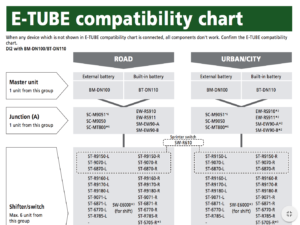
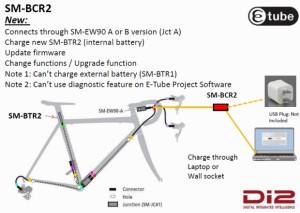
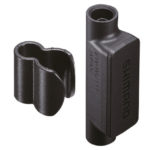
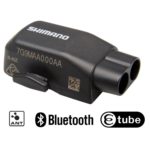
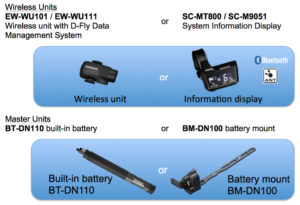
I am using a Di2 6770 system ( never had an update ) with external battery. Now I want to plug in RD9070 and FD9070. What are the do’s and don’t s with update firmware and will it work with the 6770 shifters ? Maybe I want to buy the internal battery and the SM EW- 90 3 port junction also later.
Rene, you will probably need to upgrade everything to that latest firmware. Go to a local bike shop for the upgrade, or purchase the PC adapter/charger and the SM EW-90 and internal battery and do it yourself.
I was running a 6770 RD on 9070 di2 groupset was working well Today I tryed to install multi shift on the system It said that the compatibility of the FD and RD was not right and upgraded thr firmware only on the FD now the 6770 RD doesn’t work any way to fix?
Buy a new 6770 FD or 11spees RD. they bust match no mixing.
Jayden, upgrading firmware will mean you CANNOT mix 11 speed with 10 speed RD/FD. Di2diy is correct. You will now need an 11 speed RD to make it compatible with the rest of the groupset. Also, you will have to check/update the firmware to the same firmware on your new RD to make sure it will ‘talk’ to the rest of the system.
Once done, you will be rock solid.
What terminal is postitive and which is negative, on an SM-BTR1?
I plan to wire my own LiPo 2s 7.4v battery to the SM-BMR2 battery mount. Thx!
– negative, on the battery mount, its the pin closest to the bracket that mounts to the frame, what wound would be the back of the battery that slides into the mount. however I would strongly discourage you from using a battery without a PCB, LIPO cells without protection can and will output way too much energy and kill the BMR and could damage your system. batteryspace sells a Li-Ion 14500 Battery: 7.4V 750mah with a suitable PCB. the other option would be what I sell…. http://www.ebay.com/itm/301553179943?ssPageName=STRK:MESELX:IT&_trksid=p3984.m1555.l2649
Thanks. – to the frame. + away from the frame. That works. I use flat 1300mah packs with PCBs. They work great on my DA7970 group too.
I’ve looked at your custom setups on Ebay. Good to know there is some competence behind those.
Another question.
I just got a new 6870 grouppo with an new SM-BMR1 and the front junction SM-EW67A and a bottom internal SM-JC41 junction. It doesn’t work. The green battery light comes one, however, derailleurs don’t move upon pushing buttons. I had an SM-BMR2 so I hooked that up instead. It works perfectly. All button and derailleurs move properly.
Does an SM-BMR1 (no marking) not work in 6870 groups?
Do I need to update the firmware to make it work?
The SM-BMR1 was new in package, however, maybe it’s a dud.
@Eric: “Do I need to update the firmware to make it work?”
The answer to that question is almost universally YES!
Thx! I’ve researched and found nothing on SM-BMR1 vs SM-BMR2. Do you know the difference?
Maybe BMR1 was for 6770 (needs update for 11spd) and BMR2 for 6870 and 9070.
Once updated there is no difference.
Thanks. I bought a BMR1 on Ebay and I only have 30 days to return it. Since my SM-PCE1 is on back order for at least 2 weeks, I have to be certain the BMR1 will work with a firmware update. Since there is a chance the BMR1 I bought is DOA, I may just send it back. I have no way of being certain without asking a bike shop to update it for $xx in the meantime, however, I went to both nearest shops. Neither have any Di2 parts or service. After working with Di2 for 6 months, I’m certain this is the path Shimano will take for many years to come. It’s that good. I’m just surprised my local shops can’t see that.
There is no reason to think its DOA, if the light on the EW67 lights green when pluged its likely just fine and will work without issue once updated.
My legacy Dura-Ace 7970 groupset came with a BTR1 and BMR1. I’ve just purchased an FD9070, RD6870, EW67A-E, and a JC-40 to upgrade to an 11 speed setup. Will I need to replace the BMR1? Thinking that the E2 cables won’t be accommodated because the BMR1 currently uses the 5-port cables. Thanks in advance for your reply.
It will work if you update the firmware.
For those of you without the option of mounting internally, take a look at the SM-BTC1 which is an XTR part http://www.ridextr.com/en/productdetail/sku,SM-BTC1.html.
This lets you use the internal seatpost battery in an external mount.
Key benefits:
It also acts as a 6-port Junction B
Has an internal cable management/tidy function
Lets you buy a groupset bundle – as many spec the internal battery as standard and the long cage external mount is a less elegant solution (to my eyes). Long cage external seems to be getting harder to find as well.
No need for Junction B to be screwed to exposed area on BB
You can use the new Front Junction A
You get USB charging (meaning you could potentially even top the charge up from an external battery pack (not sure what the charger specs are?)
You don’t lose a bottle cage mount – it appears to be the same dimensions as a cage mount pump.
There is no increase in cost for going this route (in fact I think I saved money overall) and it future-proofs your setup should you end up buying an internal-wired frame in the future.
Any tips for travelling with the bike in a box ? What should be disconnected to prevent accidental battery drain ? I use Ultegra 6870.
Thanks
Robin
I would disconnect the battery, unless it’s hard to get to. Otherwise, the TL-EW02 tool could be used to remove both derailleur wires.
I use my Bike Box regularly when travelling and I simply remove the battery as part of the in-flight preparation. No problems.
This is always a good idea since the temps on long international flights are quite low in the cargo bay.
Is there a problem with just leaving the seat post battery on Di2 in place and all connected while flying with a bike box? Do you know what the Wh value is for the Ultegra Di2 internal battery – BA has a good leaflet for what batteries they will allow into the hold.
Hi,
I have had 10 speed Di2 on my bike for the last 2 and a half years and it has been absolutely faultless – until now! On a recent ride, i lost the RD and, on inspection, noticed that the electrical plug to the RD was loose. I re-inserted it by hand and it seated but did not click in place. After that, the same pattern was repeated: it would be fine for a while but any bumps would disturb it and it would either go intermittent or would stop altogether. I took it to my LBS who tried using the Shimano tool to re-insert but with the same results – they told me to buy a new RD (which I now find has been discontinued!). It appears that the mechanism in the RD socket that retains the electrical plug is missing – the plug will not click in place in the socket! A bodge was next, but a drop of silicon was not enough to hold it in place for normal UK road use. My next option is either Araldite or 11 speed (I’m going for the latter option). The RD is otherwise completely serviceable… Has anyone else come across this problem and is there a fix that I’m missing???
Some dirt on some end of the connection could be the problem. It has been for me atleast in the past. Do your absolutely utmost to clean the connectionpoints. For sure inside the derailleur. Check with another cable if that ‘clicks’ in place. If so, maybe you should replace the cable.
Hi,
I’ve had Di2 on my bike for the last 2 and a half years and it’s been faultless – until now! On a recent ride, I lost control of the RD. On inspection, I found that the electrical plug had come loose. I attempted to re-insert it manually but it would not click into place. I continued the ride with it intermittent. My LBS had a look at it and tried to re-insert using the Shimano tool – to no avail. They compared it with other spare Di2 components and concluded that my RD (electrical socket) had a fault which prevented the plug clicking in place. Their verdict was a new RD (which I now know is discontinued!). I have since purchased a Shimano insertion/exertion tool and tried myself – the amount of force I have exerted without it clicking in place seems on the verge of excessive… I then resorted to some silicon to hold it in place, which failed as the connection was intermittent! My options seem to be either Araldite or a new (11sp!) RD (plus new cassette/chain and firmware update to V2.5.2!). My question is whether anyone has seen this before? Is there anything to be done to fix the RD (which works in every other way)? Am I simply not pressing hard enough (don’t want to break the electrical plug)? Grateful in advance for any advice…
There are several for sale on ebay. Also if you do go for the 11 speed RD6870 you also need to buy a FD6870 as the 10 speed FD will not work with the 11 speed RD.
Thanks. I was under the impression (from reading this page) that I could mix 10 and 11 speed so long as I stayed pre-v2.6 firmware…?
In theory its possible, in reality you will have a really difficult time and in the end you will have nothing but greef. Just do it right and update everything to the current version.
For the record, works fine with mix of 10 and 11 speed using V2.5.2 firmware (and saves a bunch of cash!)…
As long as you never ever plan to change the settings and never add or update any other components yes, and in theory it can be done. However if for any reason something goes wrong with any component and you want to do any diagnostics you will come to understand why I posted my comment. Just for the record.
It’s also worth noting that Shimano has been shipping 6870 components with v3.1 firmware a few months now, and it’s not compatible with V2.5.2 and will require the update to a mix of 6770/6870. So depending on the age of the item being being sourced it may not work, so as retailers sell out the old stock and buy new there will be no choice but to comply with using current firmware versions.
Carlton, thanks for some great information. I just wonder whether the SW-R610 Dura-Ace Sprint Shifters can be connected to ports other than the dedicated 9070 port. The diagnostic unit functions happily using a standard E-Tube connector wire connected to the Sprint Shifter’s port on the 9070s. This makes me think that removing the key [buffing it off with a nail file?] on the wire of the Sprint Shifter might work fine on any of the 9070/6870 Shifters. Has anyone tried this?
Thanks again, guys, for great info’.
If you were to plug into any port other than the sprint port it will short out the system, that’s the reason it has the key to prevent you from plugging it in anywhere else.
Got it. Thanks.
Carlton-
Thanks for your help and guidance on all this Di2 info-
I have a specialized S-Works that came with the Di2 and ST-R785 Hydraulic Road Dual Control Brake Levers/Shifters. I added the D-Fly but the shifters don’t have the button to control pages etc, (which stinks). My question is can I purchase the 9070 Dura Ace shifters and will they work ok with the disc brakes?
No, ST-9070 are not hydraulic.
You can now also get wires of 150, 200 and 250 mm length, eg.
http://www.wiggle.co.uk/shimano-di2-e-tube-individual-wire-length/
Wiggle had 10+ of the 150 mm ones yesterday, they are now all gone 🙂 As there seems to be a definite need for this length, as an additional hint: bike24.de
I’m not sure if anyone has brought this up before but have you verified the weights in relation to this point below? The Shimano docs contain an error in the mechanical front derailleur, and most articles use the incorrect weight when adding up the parts. It overstates the mechanical groupset weight by nearly 100 grams.
The Shimano Dura-Ace Di2 9070 electronic groupset with internal battery weighs 2047 grams; the Shimano Dura-Ace 9000 mechanical groupset weighs 2074 grams (27 grams more than Di2.)
This site has been great! I have the original DI2. 7970 5 pin. They are no longer supporting it, and I am trying to find an internal routing for my new frame. What part or part numbers do I need for an internal routing kit for the original?
Internal harness EW 7975, they come in two flavors, long battery or short battery mount, however I sell a modified harness that gets rid of the ugly battery on the frame and hides it in the seat post, it comes with a charger that will charge the battery without removing the seat post, charges through the RD cable, the battery last 80% longer then the Shimano battery. you can buy it directly from me or on ebay.
http://www.ebay.com/itm/291271828873?ssPageName=STRK:MESELX:IT&_trksid=p3984.m1555.l2649
I have a canyon vcls seatpost, it’s not possible to put a battery in there.
See:
http://bit.ly/1JPvp11
if unfamiliar with the post.
Is there an option to mount battery in seat tube?
Is the charger 240v capable for use in uk?
Thanks,
Lou
Yes the seat tube will work, yes the charger will work and it comes with an EU plug adaptor.
Many thanks!
Hi have just brought a bike with di2 is there a switch you need to turn off to remove the rear wheel?
No just shift it to the smallest cog and remove the wheel.
For ease of chain removal and installation simply shift the chain to the small cog on your rear cassette and remove the wheel.
I have 6770 FD and RD and external battery that I want to run on my TT bike. Are these components compatible with the RW 671 TT shifters?
Thanks
Hi Carlton.
Yesterday I connected the bike, launched e-tube and it started the update. Then as usual, it didn’t recognise BCR2; so as the last time, I uninstalled and reinstalled sw (last time it worked) but now I get the message ‘connection error…try to unplug BCR2…BCR2 may be faulted…’
So what??
Fra, you have a computer or BCR2 issue. Try a different pc. If that doesn’t work, try a new BCR2.
At last I managed to connect pc and bike:
1. I reinstalled e-tube (2.9)
2. I reinsatlled BCR2 driver
3. I launched e-tube then connected BCR2 and it worked
4. At that poin it downloaded new firmware for BCR2, then new fw for BTR2, FD and RD.
5. Installing new fw for RD it wen in ‘connection error’…after that it didn’t connect anymore and everything was dead, the whole system. No operatiing derailleurs, no light on EW90.
With ‘Connection check’ it doesn’t recognise any component and closes the connection between pc and bike.
This morning I tried again the connection.
I went directly in ‘Preset’ function then in ‘Reading the settings from the bicycle’.
At that point components recognising started (it didn’t worked Yesterday) and displaied that fw of some component was old.
I started updating then it displaied tha a component wasn’t working properly and to disconnect everything but the BTR2.
But yesterday the problem was RD…so I saved operations registry wher you can see that it recognis everything but the RD:
[Communication];23/06/2015 08:03:39,727 slot 0 : Change PC link mode to WAIT … Success
[Operation];23/06/2015 08:03:39,914 Bike window : Set ‘[ST-6870-L]’ condition to ‘Connecting’.
[Operation];23/06/2015 08:03:39,930 Bike window : Set ‘[ST-6870-R]’ condition to ‘Connecting’.
[Operation];23/06/2015 08:03:39,946 Bike window : Set ‘[SM-BTR2]’ condition to ‘Connecting’.
[Operation];23/06/2015 08:03:39,946 Bike window : Set ‘[SM-EW90-A]’ condition to ‘Connecting’.
[Operation];23/06/2015 08:03:40,008 Bike window : Set ‘[FD-6870]’ condition to ‘Connecting’.
[Operation];23/06/2015 08:03:40,117 Wizard [Preimpostazione Lettura delle impostazioni dalla bicicletta] : Show.
Reading further in the registry, you can see that the error occurred in updating BTR2 fw:
[Operation];23/06/2015 08:03:47,075 Wizard [Aggiornamento firmware] : Show.
[Communication];23/06/2015 08:03:47,371 SM-BTR2 : Send MBT_SOC2_GET
[Communication];23/06/2015 08:03:47,387 SM-BTR2 : Receive normal response to MBT_SOC2_GET
[Operation];23/06/2015 08:03:47,402 Bike window : Set ‘[SM-BTR2]’ condition to ‘Processing’.
[Communication];23/06/2015 08:03:47,558 SM-BTR2 : Begin firmware update.
[Communication];23/06/2015 08:03:48,588 SM-BCR2 : Set protocol mode UPDATE/Slave … Success
[Communication];23/06/2015 08:03:48,619 SM-BTR2 : Firmware update is failed. (process result = 0x800B)
[Operation];23/06/2015 08:03:48,682 Bike window : Set ‘[SM-BTR2]’ condition to ‘Error’.
What can I do??
Is there a way to restore everything?
I try to connect only BTR2 or only RD? How can I connect only RD?
FRA,
I have had this isssue.
Make sure your PC is as it should be.
I only overcame it by INDIVIDUALLY checking/updating each component individually. On updating the firmware on each component individually I then connected and configured the system as a whole. Now, all good.
There is no doubt [having worked on a number of systems] that the software is intolerant of errors. A mixed blessing, perhaps.
Persevere, it will all ‘talk’ in the end.
What do you mean with ‘PC is as it should be’?
Which i the first step? BTR2 or RD?
How to connect only RD? My battery is in the seatpost…
FRA
PCs are notorious for software anomalies. As your E-Tube software runs on top of the Windows software it is important that there are not ‘bugs’ in the Windows software. As I have had to address multiple E-Tube systems I have a dedicated Hard Disk used ONLY for Shimano work. This means diagnosing issues can be addressed without also working out is it my PC software and not the Di2/Shimano system.
If I were you I would remove the BTR2 and check it on its own. Then I would address each component individually completing the operation with a connected system check.
The E-Tube system will commonly try to force you to do this anyway. Once the firmware on each component is updated [individually] then the system will ‘talk’.
Carlton and Di2diy are giving you great advice.
Do you think I’d better try to install an older version of e-tube?
its not clear to me what the configuration is, 6770, 6870, 9070. Are you mixing any components. As already pointed out update one at a time… with the BCR2 you need to always go through the EW90, but if its gone bad than that could be the issue. yes the PC could also be the issue… if you cant get it working find a shop that has a SM-PCE1 to do diagnoses on the EW90, and all the components. if you did an update to a newer version e-tube project, be sure to shutdown and disconnect the BCR2 before starting e-tube again because new firmware needs to be installed on the BCR2, also remember the BCR2 cant do diagnoses and sometimes they go bad for some reason, if so I would buy the SM-PCE1 and use the BCR2 only for charging.
BTW you can not install older updates.
Is there a way to restore the Whole system??
FRA
The E-Tube software will not allow you to test and consequently restore the whole system without looking at each component.
The software [as you may know] takes a correction-by-elimination approach working its way through each component until all have been checked and updated [where needed]. Then and only then will you be able to check/update the system ‘as a whole’.
When you think about it this makes perfect sense. Shimano want to make sure each Firmware element of the System is as it should be in order to eliminate software issues. This is the method employed in identifying faulty connections/cables/components.
The E-Tube system will not allow you to take shortcuts for this reason.
I repeat, Carlton and Di2diy are giving you first class advice.
FRA
It is good practice to use the latest E-Tube software.
Remove your BRT2 from your bike and connect it to the E-Tube for checking. Follow the instructions to update Firmware, if needed.
Then do the same with the RD, FD, STIs etc., until you are sure all components are okay individually.
I know it is frustrating checking components that you believe are okay, however, following Shimano’s process will provide the best results.
In my previous post I mentioned the importance of a healthy PC system. After all, no point in slavishly checking and rechecking Di2 systems only to find out that the issue was your computer. Hence many use dedicated Windows systems which enables them to know the issue must be the Di2.
As Carlton suggested, the issue is either your computer or your BTR2. I only add, it could be a combination of both, logically.
However, it is most likely resolvable by painstakingly following the Shimano process of elimination. I, Carlton and Di2diy are pointing you in that direction.
I only add, the LAST thing I would do is spend dollars on a new BTR2. Only after checking the BTR2 [individually] and finding it has a confirmed fault would I spend money on a new BTR2.
Get on your bike and ride . . . !
BCR2 not BTR2 in case…but I agree with you, the last thing I’ll do would be buying a new BCR2.
The only pain in the ass is disconnecting the BTR2…
Coming in late to this incredibly valuable thread… Thank you!!
I am looking to upgrade my P5 from Gen1 Di2 due to a crash. Sobering to see Shimano abandon that group, I can’t find those parts anymore. Not a genius and sitting on a lot of 10 sp cogs/wheels, so was leaning toward 6770.
Now it appears Shimano has discontinued 6770, or at least the RD? Is that really possible? Am I then left with only 6870 or DA options? And tossing the existing 10 sp cogs?
More importantly, and w/o any emotion, am I wrong to be offended by this type of behavior (abandoning support for previous groups so soon)? I’m pretty green, but this seems bizarre that I could make such an investment that could be obsolete if something breaks in a year or two…
Have you looked on ebay, I see plenty of both and if you only need the RD to replace one part it’s not going to set you back too much. On the other hand the ultegra 6870 workes really well, I have been able to put teogather a complet group for <$1000 new.
Hi. Solved!
It was the pc.
After other many tries to connect the bike, I decided to install e-tube on my old desktop and it connected!
So I connected only BTR2 and it updated that fw. Then I tried to connect all but it didn’t recognise RD.
So I connected only RD and it started to restore fw….at the first try, e-tube crashed, but at the second one it went over.
So difficult…I think I won’t open e-tube no more
@Di2diy: I have 6870 and not mixing components
FRA,
just as we thought. Congratulations!
Hi Carlton,
I put together a table that shows timeline of the E-tube versions and Firmware versions for Di2 road components with dates of release.
I can share it in PDF or Excel if anyone would like a copy. Just not sure how to best do it.
Shimano has all this info in a live page including individual componets. can be forun at http://e-tubeproject.shimano.com/
Hi just purchased a boardman sls 9.4 with Ultegra di2 and I don’t seem to be able to get it to work. I unplug the battery and then reconnect it and it works but after a short period minutes it will cease to work again.
Something somewhere is loose.
Di2 is very robust, it’s unlikely to be a faulty part, on a new bike it’s almost certainly a build problem.
If you have the plastic tool that pushes the connectors in, go round each of them and make sure they’re secure. If not go back to the shop and get them to do it.
Thanks Lou,
Will try and find the connection which has not clicked home, the bike was shipped from the UK so popping along to LBS is not so easy
Hi Carlton,
Great site, and thanks for collecting and sharing the valuable information. I recently took the plunge to install 6870 Di2. However, it works smoothly only for 1 ride. The almost-new RD-6870 stopped responding to up/down shifts as I tested it at home, on a stand, and the EW90B button doesn’t activate the adjust mode anymore (as if no RD connection is detected). The FD continues to work flawlessly. I’ve tried disconnecting and reconnecting the internal battery to no avail.
I thought it was bad connections at first, and bought new wires and made sure to “click” in every plug, but still no RD shifts. All components have the latest firmware. After some elimination , I connected only the RD & int battery (& EW90B) to e-tube and found something strange:
(i) RD-6870 + EW90B + BCR2 + PC
RD is recognized by e-tube, RD firmware version 2.6.2. I don’t have a PCE1 so I couldn’t test the shifting here without the battery. I’d say the RD plug/wire is ok.
(ii) BTR2 + EW90B + BCR2 + PC
battery recognized by e-tube, BTR2 firmware version 3.0.10
(iii) RD-6870 + BTR2 + EW90B + BCR2 + PC
RD *NOT* recognized by e-tube, battery & EW90B are recognized
(iv) add more parts to (iii) and everything would be recognize and works fine, except the RD not being recognized.
The strange thing in (iii): If I unplug the battery and then replug, fire up “connection check” within 30sec, the RD *IS* recognized half of the times. I can adjust and shift the RD through e-tube, which means the motor/sensor are fine, and it’s not in crash save mode.
Without touching the wire or plug, if I end the session, and restart “connection check”, the RD isn’t detected anymore.
I notice the latest RD-6870 firmware says “Fixed SM-BTR2 bug”, not sure if this is related. It seems like for some reasons, the RD, when powered, doesn’t respond to shifts not e-tube commands. I got a new BTR2 battery and it’s behaving the same way. Did anyone have similar experience, and did it get resolved? Thanks!
It sounds like you are disconnecting the wires while etube is running and it’s on the system that CAN/ WILL damage the FPGA of what ever component you are disconnecting, if so, don’t do that anymore. Try disconnecting every thing except the EW90 and the RD and see if it’s the RD. if you have a 2 spare wires do it with just the EW90 and the spare wire, you do not need the battery to be in the system to check that it can see the RD, this will eliminate that it’s the wiring inside somewhere. Also remove the rear wheel and see if you can make the RD go into crash recovery mode by holding down the button on the EW90. If it can’t do fine adjust and recovery than it’s likely the RD.
Thanks. I didn’t mentioned, but I did click “complete setup” every time to end the sessions before I change wiring. I do have new spare wires, and I tried your suggestions:
Connecting RD-6870 + EW90B + BCR2, the RD is always detected. But adding the battery, the RD will disappear from e-tube (colored red).
When the EW90B button is pressed, the RD doesn’t go into recovery mode. in fact the EW90B adj red LED doesn’t light up (same as if no RD is connected). But since I also need to add the battery for this test, I’m not sure if RD is faulty, or it isn’t compatible with the battery. I have 2 BTR though and it’s doing the same thing with both.
Henry, Di2 has cracked it before you ‘tried’. RD needs updating. You are best advised to use the SM-PCE1 or ask your LBS to do it.
Of course, if you have been disconnecting DURING diagnostics your may have irreparably damaged the firmware. Di2diy spotted this danger.
Let us know how your LBS manages with the RD check/update to the latest firmware.
Keep going, mate, your resolution is on its way.
With this new info it’s pointing to the cable to the battery, or the battery its self. The FPGA CPU functions are stored in the power source / battery mount, for external battery systems, or internal battery BTR2, I have seen both fail and it seems the failure mode for the BTR2 is battery installation, be sure the battery is not installed too tightly in the post as the foil wiring harness wraps around the inside of the battery case causing the insulation resistance to breakdown. So try removing tha battery’s, after verifying that it’s not the battery cable, by using one of your spare wires. And of course the PCE1 is the most helpful tool for any diagnosis. But I would still not rule out the RD as the lack of fine adjust+no recovery are present, i’m symptoms of a RD ready to fail completely.
thinking about it I failed to answer you question about compatible… if the RD is detected, and not current e tube project will tell you, you can also check the RD for what ver. is installed by clicking on update. etube project current version is 2.10.0, the RD is 2.6.2, BTR2 is 3.0.10, as long as both/all components are up to date they are compatible.
Right, that’s the versions I got and etube says all parts have the latest fw in my (i) and (ii) tests.
In (iii), as the RD is not found, etube would ask me to connect only the RD (disconnect BTR2) and click ‘next’ to restore its fw. Once I did that, it then said the firmware is working normally, no need to be restored.
Good counsel from Di2diy. The RD as the ‘brains’ of the Di2 system is your likely issue, especially as you have confirmed the firmware is not updating.
NEVER disconnect components DURING a test. You should follow Shimano’s directions to the letter and save yourself repeating corrections, wasting loads of time and avoid damaging your system. Shortcuts are not always the best. And be warned sometimes a corrupted firmware is irreversible. Hence Shimano’s warning apropos disconnecting during diagnostic testing and firmware updates.
If you don’t have the SM-PCE1 tool save yourself some hassle and time and pop down to your local bike shop and ask them to check/update the RD to version 3.x.x of the firmware. Connect it up to your Di2 system and see if that works.
If you don’t have access to your LBS or someone’s SM-PCE1 tool you may find it more difficult to isolate the issue.
Meantime, don’t stop cycling. Enjoy Di2; it is superb when properly installed and maintained.
Thanks for your comments. I clicked “complete setup” every time to disconnect between tests, I skipped that to keep the post short.
Anyways, e-tube said all the components have the latest firmware version. It’s just that RD stop responding when the BTR2 is attached. v2.6.2 is the latest for RD6870. http://e-tubeproject.shimano.com/history.html?type=road-bikes&series=&model=RD-6870
I’ll try to locate a PCE1, but to not stop cycling, I need to switch back to mechanical for the moment. 🙁
If you read older posts, My RD stopped to work some weeks ago.
For me the trick was connecting only EW90 and RD, so etube restored faulted fw of RD.
Henry,
The more information we get on this the more Di2diy is on the money. Increasingly this looks like a data-syncronisation [system ‘talking’] issue. PCE1 is the way to go for a happy resolution.
Without being a ‘prophet’ let me make a ‘prophecy’ with a small ‘p’. Using the PCE1 will allow you [or your LBS/mate] correct this issue.
We all look forward to your writing ‘job done’ ‘all good’.
Keep spinning and stay safe, mate.
Thank you for all your helpful comments. I went to a rather experienced bike shop last weekend and the mechanic helped the diagnosis with the PCE1. The PCE1 diagnosis turns up the same symptoms as with my BCR2 charger, that when a battery is connected, the RD doesn’t respond to pings. (Red colored. A new battery is also tried). Without the battery, the RD can be commanded by the PC to do up/down shifts and adjustments.
The only extra capability of the PCE1 is to force overwrite the latest RD firmware, which we tried. Upon completion, it still doesn’t cure the issue. Same thing happened. We gave up after spending 1.5hr (un)plugging cables and clicking the e-tube software.
I am going to return the RD to the store I purchased it from, and try another one. Now that I think of it, I’m not sure if the ‘new’ RD I got was a returned item or not.
I suspected the RD from your first post, a new one will get you back on the road.
The Garmin Edge 510 and 810 (with latest firmware) both support the SM-EWW01 now and can display current gear and battery level.
Hi
I’ve just switched wheels and cassette (both 11 speed) from 12-27 to 11-28. I can get the Ultegra 6870 di2 to shift nicely into every gear except the 11 tooth where it just won’t go even with the limit screw slackened right off. Any ideas? Thanks
Check the rear derailleur hanger alignment. I use a Park DAG-2, but there are others. Also chain length/age can cause that, but first I would check alignment.
I just gotten a bike with di2 6870 system. I am adding my profile bars (Aero Carbon Strike) to the bike and I was thinking that I would be able to mount the climbing switches to these bars but the wires on the switches are too short to plug into the existing shifter (under the brake hoods). Can I use these switches for this application? Is there a way to “extend” the cable so they will plug into the brake hood area? Can I use a 5 port junction box and plug the climbing switches along with the brake lever shifters into the junction box? Thank you, Barry
So I have a 6770 10 speed system from a 2013 BMC. I’ve decided to do an 11 speed upgrade on it and bought a new hub, cassette, chain and a 6870 RD. As far as I know, the system has the original FW from when it was shipped although I bought the bike as a demo model in the spring of this year.
It appears that a 6870 RD should be a plug and play component as long as my system does not have FW 2.6 installed so I unplugged the 6770 RD tonight and plugged in the 6870 RD.
Nothing happens when I click the shifter button for the RD. The front still moves, but the rear does not. I switched the DR’s around and the 10 speed works again.
Could it be that I have a bad RD? Can I get the FW checked without getting it updated?
Most likely the new front derailer shipped with new firmware, making it incompatible with the older firmware in your existing components. Your only option is to get a new front derailer and update the firmware on all of your other existing components.
So I bought a new FD-6870, RD-6870 and SM-PCE1. I also have a new hub, cassette, chain and 6800 crank to complete the swap to 11 speed, but am still waiting for the SM-PCE1 to arrive.
Now the question is, do I install all the components on the bike, then connect the SM-PCE1 to update the entire system, or should I update each component individually before installing them?
It most likely doesn’t matter, but I do get a little nervous updating FW in anything. It seems sometimes too much data at one time trips things up.
I would first plug it all in to see if it works, if it does ride the bike. There is no reason to stress out over updating firmware.
I assumed the battery would have to updated to work with the newer 6870 FW, but apparently not?
No way to know unless you plug it in, it may all work depending on what firmware is. If it doesn’t work than updat it, and that should all be good. You may want to change the multi shift settings and if the firmware doesn’t match than you will be prompted to update whatever needs updating. Give it a try and see, may be surprised.
FYI, I just tried plugging the FD-6870 and RD-6870 in and clicking the shifter buttons but nothing happened, so it appears the battery needs an update to work with the 6870’s.
BTW, I like that Shimano changed the location of the connection on the FD for the 6870. It connects in the bottom rear instead of the top front side. When I unplugged the FD-6770, the housing was packed with sand from the time I had to ride in the rain.
Received the sm-pce1 today and swapped over everything I needed to go 11-speed. Installed the e-tube software and plugged in the pce1. The driver fails to load and I’m now sitting here with a dead system and no idea how the hell to get the pce1 to load the fing driver. $140 down the drain.
It’s a Windows problem. Do the standard stuff. Reboot, uninstall, reboot, reinstall, etc. Hopefully you’re not running it on a virtual machine on a Mac as that can be problematic.
Carlton is somewhat correct when he warns us that Virtual Machines running Windows on Macs can create problems. However, if you partition [or use a dedicated HD] to run Windows on your Mac [without Virtual Machines] you will find this a more problem free platform on which to run the PCE1 software.
I have run a dedicated Windows HD on my Mac for some time and ONLY USE IT FOR Di2 WORK. I have NEVER had any communication issues [bugs] doing it that way.
Of course, you can do exactly the same thing on a dedicated partitioned PC drive.
I have found it important to exercise patience when running the diagnostic software.
No software will resolve hardware failing RDs. Components, by their nature, are subject to wear and tear which varies with users and conditions.
But we love Di2, nonetheless.
I gave up trying to get my Windows 7 PC to work and used my daughters Windows 8 machine. It took a couple uninstalls and reinstalls, but it finally connected with the pc controller.
I had to install new FW in all the components to get it to work, but its working now. Thanks for all the help.
Actually it’s the firmware in the RD. I alerted the forum some time ago that shimano has updated the RDs shipped after May 2015, although some vendors still have older stock, at some point only newer stock will be available. You will need to buy a new 11 speed FD. You will likely need to update everything as well.
Just my luck. I bought a used RD thinking I shouldn’t have any compatibility issues. So if I get a new 6870 FD, I will have to take my bike to the LBS and have the entire system updated to the newest FW, OR buy a SM-PCE1 and do it myself?
U will also need to buy a new FD, in case you missed that.
Yeah, I got the part about a new FD. Thanks you.
What did you do with your 6770 rear derraileur? I need one and it’s hard to find.
I actually returned that 6870 RD one in hopes of finding a 6870 with the old firmware on it but finally gave up on that. I’ve ordered a new FD and RD and am waiting for delivery. After I have them installed and operating, I will be selling both of the 6770 derailleurs.
Just wanted to update this by stating I finally got the system together, updated and running. Its working great thus far and actually seems to shift better and run quieter then the 10 speed system that my bike was originally fitted with.
Thank you to Carlton for this site and the rest of the very knowledgeable contributors (Di2diy and James Frew) to this site for answering questions and sharing their knowledge along the way.
Hi, the uppers buttons don’t work on my dura ace di2, speed, power, cad, gear indicator are fine but impossible to switch screens on the display of the pro scio, one idea ?
tx
Much to my surprise it looks like my BTR1 is dead flat. Doesn’t make sense as the battery was charged about a week ago.
No shifting, no lights come on when the battery level/adjustment button is pressed. Removed the battery, grabbed a volt meter and tested between the terminals.
If the charger wasn’t a few hours drive away I would plug the battery into the charger and see what happens.
Any thoughts as to what would cause the battery to drain?
Happened to me, Colan. Checked all my Di2 system and found out I had simply leant the bike against the shifter button. Ockham’s Razor approach before any other, I reckon.
Love your Di2.
This article has been extremely helpful, I am far more informed about Di2 and definitely looking into upgrading!
Thank you so much!
Hi , I have been riding a bike 2015 giant propel with the full ultegra 6870 di2 front and rear mech I have how ever got my hand on a full set for dura ace 9070 di2 set including the 9000 shifters, fc9000 50×34 crank set & cs9000 11x 28 cassette .
Now the question I have is it a straight swap from what I have to the dura ace and the do I also have to change the press fit bottom bracket to a dura ace one . The shimano software / frame wear appear to be the same according to shimano website . Or do I still need to plug the bike in and update once I’ve transferred the components over
If you have already been running an Ultegra crankset and your BB is still good there is no need to swap it out.
I would leave the Ultegra BB in until it needed replacing. Othewise, check/update all the firmware. Once all is checked and connected up it is simply a case of fine adjustment in the usual Di2 way.
Many thanks that puts mt mind at rest , i will change it over as soon as it arrived.
Neil
Ditto as James had advised re using the same BB, but if you want to save a bit of money i would be tempted to leave updating your firmware, if you would have to visit your LBS to do so and see if everything works ok first. If the Dura Ace gear worked ok before, theres no reason for it not to work after your install. I personally try to avoid firmware updates as long as i can get away with as strange things happen sometimes when updating as can be testified by previous experiences on this brilliant forum. Only when things arent working properly do i update. My personal opinion only though!
I have shifting delay on one gear only on my 11 speed and it’s driving me crazy.
It’s been indexed about three times but to no success.
Any pointers would be amazing.
Luke.
Neil, have you had the RD mechanism checked? Mere re-indexing won’t fix that issue. I am assuming your cassette and chain are all good.
Opps, Luke, not Neil.
Thanks so much for the detailed write up. Please excuse the stupid question but I have a Durace di2 with matching durace 11-28 11 speed cassette. I cannot find any reliable information about changing rear cassette to either a 30 or 32. Is it something easily done?
John, the answer to your question should be in the Shimano service manual. As I recall, 28 teeth is the limit for the standard length rear derailleur cage. You’d need to mod to a longer derailleur cage for it to work on a larger rear sprocket.
John, you have to run an Ultegra RD in order to utilize cassettes larger than 28. Even the Pros have to have the team mechanics swap to Ultegra. I think it’s only a matter of time before Shimano releases a DuraAce RD with longer cage
Jon, you must use the Shimano medium cage derailleur. There is no Dura Ace RD to cope with a cassette ring larger than 28t. If you try to run a 30t or 32t ring on your cassette the upper jockey wheel would foul the larger ring. Look at Pros riding the Giro and you will see Dura Ace systems with an Ultegra RD [medium cage]. This allows riders to run a superb climbing ring [32t] with a great descending/flat ring [11t]. Some riders even pop on a compact Dura Ace crankset with a 32t cassette ring when climbing. As Froome commented recently in an interview, it is best to have a ‘spare ring’ on the back than struggle with a smaller ring. If you want to ‘spin like Froome’ up those climbs you will need that rear leverage.
Changing your cassette is a simple task using the right tools. Just note; when using an 11-speed drivetrain you must remove the 10-speed adjustment washer that comes with 11/10-speed compatible wheelsets.
Hope this helps.
Question re cranksets. Can you fit a Dura Ace 7900 stages power crank with an Ultegra 6703 chainset?
Ian, mixing 11-speed rings with 10-speed chains isn’t recommended by Shimano, but in practice it works reasonably well. You should have no issue using 10-speed chain with 10-speed rings / sprockets, even across 7900 and 6700.
Thanks Carlton. All I want to do really is buy a stages crank in either dura ace or ultegra and use it with my other chainsets so mixing the power crank with ultegra or 105. I just wondered if there was any subtle difference.
Hollowtech cranks are identical at the spindle interface, they vary only in appearance and a weight difference so small it’s irrelevant.
Shimano would like you to think that the Dura Ace is stiffer than 105 or Ultegra…
Lou, as a long-time Shimano user running 105, Ultegra and Dura Ace systems I can assure you Dura Ace is the top for good reason. I won’t give you the numbers as you can look at all these yourself on Shimano’s web site.
Note: 105 will NOT last as well as Ultegra or DA. Ultegra is a fantastic choice for those on a tighter budget. If you can afford Dura Ace, you won’t regret it.
You will have no issue popping a Stages Power Meter onto your Shimano crankset.
Make sure you choose the correct crank arm length to suit your riding terrain, riding style and body-type. Most local bike shops overlook the important details of this element of the fit. Only when you have this information settled in your mind should you buy your crankset with the arm length of choice. Otherwise, you might regret your purchase and end up paying double in the long run.
Opps, I meant Ian.
Dura Ace is probably better in lots of ways, but in the specific case of a LH dura ace crank vs. a LH 105 crank I think it’d be very hard to find a measurable difference.
It makes me chuckle a bit when I see the significant price difference for 105 stages and Dura Ace stages. There will be no appreciable difference for the rider.
I can confirm that SC705 Alfine display works with road di units. Since the E-tube software was updated in line with the Shimano Compatibility chart (http://e-tubeproject.shimano.com/pdf/HM-CC.2.10.0-00-EN.pdf) it is really easy to update all the items. Once updated they work great together. I have a 1×11 setup with the SW-R600 climbing switch unit connected to the single out of the SC705 Alfine display – the single in then back to a junction box with one hole blanked and the other two connected to the internal battery and a RD6870 Rear Der (11spd). If you needed two switch units due to a FD then you will need a junction box between the units and an extra wire then to the SC705 (it has no problem using two units even though
The RD-only approach I have, has got to be one of the cheaper ways of getting into Di2 and creates an awesome city bike (I run a single 41 cog at the front – although most people may prefer a 39 or 40 – then a 11-28 on the back. Even better would be the mid-cage version of the RD which would allow an 11-32 on the back if you have some serious hills around). You are looking at (all very approximate as I am in Japan and Fx’ing the prices) $50 for the wires, $200 for the RD, $20 for the junction box, $50 for the switch, $50 for the display and $? for the battery.
Four notes for this set-up
i) There is no “on the go” RD adjustment using the SC705 (no button to press on it). You have to plug into the computer and do the fine adjustment by e-tube software (very easy)
ii) There is no post-crash RD reset on the SC705 – so again if you have a crash and the RD sticks in the lowest gear you do the reset by the PC when back home. (I’ve never had a big enough crash to trigger the protection BTW)
iii) And most important note of all (for me anyway) Check your e-tube software! If you have a version prior to 2.10.0 (latest as of July 2015) you might need to uninstall and install the new version from the Shimano website. I was on 2.2.5 and it was saying there are no new versions of the e-tube software when it was doing its auto-update-check. Seems the software made a big leap after that and the auto-update doesn’t work for that old version anymore. The parts were not fully updated to their latest software using this old e-tube version and hence didn’t work together
iv) choose Road on the first menu in E-tube software to be able to update/reset/customise the above units I mentioned.
Thank you for the fantastic site Carlton.
Macrophotofly, I’m looking at doing a similar 1×11 drivetrain and I want to use the SW R600 climbing switch along with the RD6870, internal battery and the SM EW90A junction box. Except I want to mount the junction box under the saddle and splice a longer cable onto the short attached SW R600 cable. Do you or anyone else know if this will work?
Also from your setup I understand the “B” junction box is not a necessary component. Is this correct?
Thanks,
JM
Yes that should work after its all updated with the latest firmware. Putting the junction A under the seat post is a cool setup, it only needs one cable going to it but you can use it like a junction B if you need it for plugging in stuff, junction B is only needed for plugging in cables.
Hi, for more then a year I ride Shimano Ultegra Di2 on my Merckx EMX!.
I use the SM BTR1 external battery. The last few weeks during a ride it stops functioning. Sometimes when I take my bike out off the garage the systems does not function. When I remove and replace the battery the system functions again for a while. Yesterday during a ride of 152km I had to remove and replace the battery 3 times. I cleaned the contact of the holder and the battery but the problem is not solved. Do you have any suggestions?
My 6770 system started having some problems with intermittent shifting etc and within a few days failed completely with no power to shifters or f/r derailleur.
The cause in my case was a broken connection in the external battery holder, it wasn’t possible to fix so was replaced. Unfortunately I can’t think of a good way to test this without a replacement battery holder.
Thanks for your answer. I have tested it with another batterymount and the problems was not solved. I will now try to replace some cables hoping it will work flawless again.
if you have a bb30 bottom bracket it is possible the wires have become fraid by rubbing if not secured away from crank properly
The wires are not in the bottom bracket. I put a piece of aluminium foil into the holes of battery so there is more pressure to the contacts. I hope this solves the problem.
I have a specialized shiv pro race tt bike and want to fit sprint shifters I can not use shimarno brake levers as the bike is fitted with magura hydraulic brakes have you any surgestions thanks Ian
It has been seen Pro racers, removing the buttons from the Brakeshiftes, and glueing them on the Magura brake levers.
You could also DIY you own buttonts, and run the wires from the Aero shiftes in your extentions to your own buttons mountet/glued on the magura brakes. http://www.bikesnbites.com/attached/image/20140922/20140922195139_64635.jpg
Try googling DI2 on magura brakes (there are alot of tweeks)
Hi
Is it possible to connect the XTR Di2 SC-M9050 Display unit with the Ultegra 6870 system ?
Will it work correctly ?
Yes, the display unit will work correctly as long as everything has the latest firmware. Another option to display the current gear selection is to use the ANT+ transmitter and a newer Garmin cycling computer. (This is what I do, with a Garmin Edge 510.)
Thanks alot 🙂
Thought about using the D-Fly unit you are mentioning but like the integrated option better.
Does it matter where you place the cables in the junction box? Sm-Ew90-B
Regards Flemming
It doesn’t matter which wires are in which sockets for any of the junctions.
It also doesn’t matter where the junction is placed. It can be anywhere like under the seat, also note that there only needs to be one wire plugged into the junction, it will be recognized and work just fine.
Help please!
6770 system soured working after almost 3 years. Assumed it was the battery mount but replacing this did nothing.
LBS now saying the junction box and rear mech aren’t showing up on software so they think both parts need replacing, seems odd to have both parts fail at the same time.
I don’t yet know how they have tried each part individually, as reading this they need to have the same firmware.
Can someone help as this could get expensive!
What are the symptoms, what working what’s not, replaced the battery or just the mount? Battery check shows what?
Hi
Went to the shop and they’ve shown me the rear mech and junction box with the light on are non responsive when logged in to the PC.
junction box replaces but not plugged in as they think the mech may be the issue causing this to also fail.
Seems odd both things have failed on me. Will try a mech from another bike to see if when all connected back up the rear mech and junction box work.
Although, nite my firmware has been updated I don’t know if my friends rear mech will now be compatible, how can I tell if it’s firmware issues or something else? I.e if I plug his mech in and it doesn’t work, is there another issue, or is it just firmware compatibility?
Updating the firmware on each component will enable the system to communicate as a ‘system’. Until each component has the compatible firmware [i.e. the latest] you will have issues. Once this is done your PC will be able to configure the various components to your preference.
Enjoy.
It’s still not clear just what the symptoms are except you say you replaced the SM BMR and the EW90, and it sounds like the RD in not working. I assume the LBS had a SM PCE1 and that’s where you saw the RD and EW90 were a no show. You can try another RD and see if it works if not you can assume nothing about the firmware, it may even work without updated firmware. Without a PCE1 you just can’t tell what’s going on with the system. So did the new EW90 show up on the PCE1? Did you try the RD with the new EW90? What does the battery check show?
Hello,
Best source of information and advice I can find on a product which hs woeful advice from manufacturer! I’ve just bought bike with Ultegra 6870, I’ve got a triathlon this weekend, and have bought double button tt end shifters sw-r617. If I saw my aero bars down a bit, the cable should reach the 6870 brifters. Did a dry run on both left and right, and sad to say neither tt shifter made any movements at all to either mech. Everything I read seems to suggest this should have ‘plugged and played’
A. Is this a firmware problem that you experts speak of!? Or,
B. Do I have to invest in 3 or 5 port junction box as well? I hope not. Heavier bike, lighter wallet.
Thanks in anticipation…
You will need to update the firmware and then they will work. Yon can program them as well to shift up or down from what ever button. An long as you can plug them into the levers (center port) they will work.
That’s also my question. How to update firmware, when I have older SM-EW67 A-E junction?
– I would prefer to connect wireless module, and update through it and leave the wireless module connected there. But old junction supports only old SM-EWW01 and I cannot find it anywhere. And would the update via this work?
– Is it possible just to change the junction for SM-EW90 (A or B I don’t care)? Would then whole system work? With FD and RD 6770 (10 speed)? According to compatibility table it should work.
You can build a cable that connects to the USB PC tool on one end to a Di2 connector on the other end, but that’s complicated. Your best bet is to get the EW90 and use the USB PC adapter and software to update the firmware.
the Bluetooth adapter won’t work with your system until you first update your component firmware to support the Bluetooth adapter. So you have to do and update with the EW90 and the USB PC adapter to get the Bluetooth adapter to work in the first place.